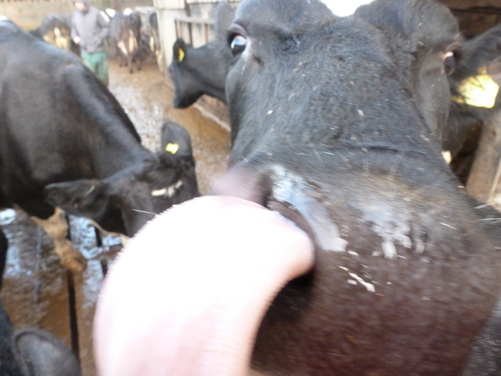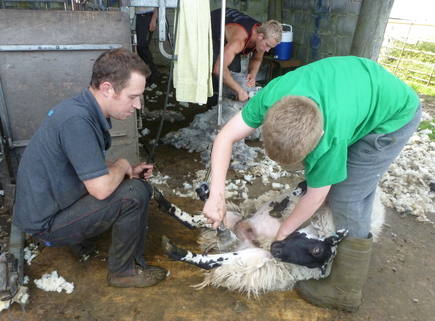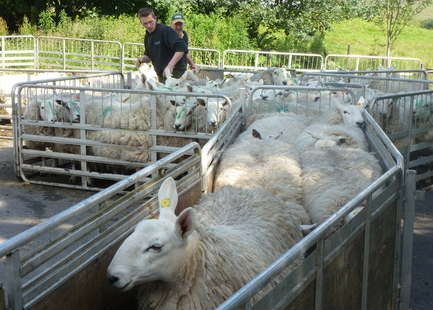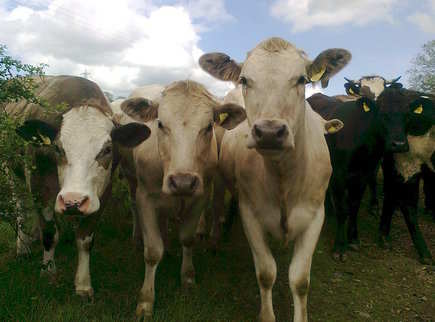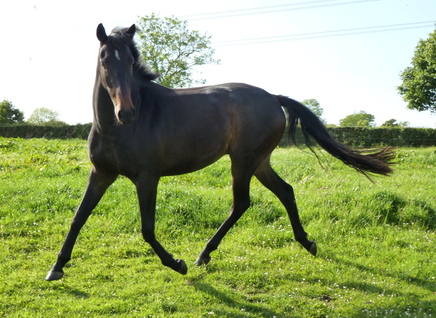FAQ'sWe hope that you find this page useful and that it will answer any questions that you may have about us and our products and services, however please do not hesitate to get in touch by email or phone if you have any other queries that are not addressed here. The FAQ's are divided into four sections - General, Sheep, Cattle and Horses. We will continue to update the FAQ's to ensure that they are as comprehensive as possible and that we've got it licked!
General Enquiries Q - What area do you cover, how far do you travel? We currently offer our services across Lancashire, South Cumbria, North and West Yorkshire. However we have operated in Wales and further afield on request, please get in touch to discuss your situation. Q - Will Ross Anthony always carry out work on my farm? All cattle foot trimming will be carried out by Ross Anthony. Shearing, belly clipping and other services may be carried out by other members of the team, if you specifically require Ross to carry out work then please let us know and we will check his availability. Q - What happens if there is an accident on farm whilst RALS Ltd are carrying out any services? RALS Ltd is fully insured for any accident involving persons and stock. Q - I don't have mains electricity on site, can RALS Ltd still operate? Yes, we carry generators on board so that in the absence of mains electricity or in the event of a power failure we can continue to shear and belly clip sheep. However, we do require mains electricity to operate the cattle crush. Q - I work elsewhere during the week, can RALS Ltd carry out an early, late or weekend visit? Yes, please advise us of your requirements and we will do our best to accommodate them. Q - Are all members of the RALS Ltd team experienced and qualified? Yes, all members of the RALS Ltd team are experienced and qualified, for further information please look at our team member profiles. We try to ensure the continual development of our team so you can be guaranteed the highest level of service. Q - My farml/land is difficult to access, do you have 4 wheel drive vehicles? Yes, please advise us of any potential access issues when arranging your visit so that we may plan accordingly. Q - I am not available and I don't have staff to help, can you provide anyone to gather, pen and sort livestock? Yes, we may be able to provide someone to gather, pen and sort your livestock. This must be pre-arranged to ensure that all operations run smoothly and to time. Please advise us of your exact requirements. Q - How far in advance do I need to book a visit? We endeavour to accommodate your wishes as much as possible and fit in with your situation, if you have any deadlines to meet for work to be carried out (e.g. sheep need belly clipping prior to sale) then please give us as much notice as possible to avoid disappointment. We are able to set up regular visit dates for you if you wish. Q - Can I pay my bill online? Yes, if you wish we can provide you with RALS Ltd account details and you may pay your bill online. Otherwise you may pay by cheque.
Sheep Q - I only have one or two sheep will you shear them? Yes, however it is likely that we will try and arrange your visit alongside another nearby appointment so please try and give us as much notice as possible. Q - Will you shear alpacas and goats? Yes, we currently shear alpacas and goats. Q - I won't be available to pen and/or sort my flock for shearing, is this ok? Yes, as long as the flock are gathered and penned prior to our arrival and you have pre-arranged such help with us beforehand then we can pen and sort your sheep throughout shearing and split off lambs etc. If pre-arranged, we may also be able to gather your sheep for/with you as we have a contact who trains and works sheepdogs. Q - Can we/you drench and/or apply any other treatments during shearing? Yes, please discuss this with us when you arrange your visit so that we may plan it accordingly to ensure best use of time and staff. With a small number of sheep it may be possible to drench or apply other treatments whilst each sheep is still held by the shearer, however, with larger numbers it is likely that it will be more suitable to do so afterwards. Q - What handling/penning facilities do we need? In addition to the shearing trailer, we carry two 8' Prattley sheep hurdles, one of which has a shedding gate. These can either be used to create a race for the sheep to enter the trailer or may be joined onto your existing facilities if necessary. We now also carry and extra prattley hurdle and penning gate. Q - What size trailer do you use, will it fit where I want to shear my sheep? Our shearing trailers measure approx. 10' x 5' and will be towed in place by a large 4x4 vehicle, however they can be pushed a short distance by hand if need be, but please advise us if this is likely to be the case. Q - Do u need to shear indoors? No, we can shear outside but do bear in mind that our visit will then be subject to weather conditions. If the weather worsens during shearing outside then it may be necessary to complete it another day. In the (rare!) event of sunshine when shearing outdoors then a shearing site that offers some shade would be greatly appreciated where possible. Q - How many sheep can you shear in a day? We can provide two shearing trailers and between one and six shearers. Three shearers operating one trailer can shear approximately 1000 sheep in a day. This is of course dependant on a large number of factors such as size of sheep and penning arrangements. Q - My sheep are wet, will you still shear them? Whilst it is possible to shear wet sheep we advise against this as you will get a greatly reduced price for their fleeces. Q - Can you provide a wool wrapper? Yes, we can provide a wool wrapper to sort and wrap your fleeces and sew up the wool bags. We will provide a wool packing frame but you will need to provide wool bags and string which are obtained from the British Wool Marketing Board. If you require a wool wrapper then this must be pre arranged. Q - How can we obtain the best price for our wool? Ensure that fleeces are free from dags of faeces by having sheep tailed throughout the year. Where possible prevent the sheep from accessing areas of land that are particularly wet or muddy or where a great deal of vegetation is present that may then become entangled in the fleece. It is also advisable not to over-mark the fleeces prior to shearing and to only use British Wool Marketing Board approved markers. It may also be useful to refer to the British Wool Marketing Board for further information. Care should also be taken when choosing the shearing site (e.g. if sheds/yards contain loose straw, this may then contaminate the shorn fleeces) and to ensure that sheep are dry for shearing and that the packed wool bags are also kept dry. Q - Will you carry out drenching, castrations and ear tagging on my flock? Yes, we can carry out these procedures for you and/or we can provide guidance so that you can carry out these tasks in the future. You will need to provide all the equipment and products (e.g. drench and ear tags). Q - Can you help me with my record keeping? Yes, we provide a record keeping service for farmers to ensure that you are fully compliant with current legislation. These records can be in electronic or book form. Q - What are the benefits of faecal egg counts (FEC) for my flock? The benefits are many. Please see the relevant News pages for more information, but in short, FEC will enable you to monitor your flocks worm status and thus allow you to then manage it. They will allow you to achieve improved growth and performance in your flock and reduce labour and costs whilst also slowing the problem of worm resistance. Q - Do I need need to provide FEC samples for every batch of sheep? Yes, this will enable us to build a up a picture of the worm status for different groups of animals on different areas of the farm, thus enabling us to advise on a correct parasite control strategy (e.g. resting certain areas of pasture or adjusting stocking ratios). Q - How often do I need to provide FEC samples? There is a common misconception that FEC can only be used to decide whether or not to drench. It is advised that in order to provide management information FEC must be carried out regularly at certain times of year. Between 30 - 90 composite tests per season would be fairly standard. Q - How can I provide you with my FEC samples? We can come out on farm to collect samples ourselves or from you, or you may post them first class or deliver them to us if this is more convenient. Q - How soon will I know the results for my FEC samples? We will endeavour to give you your FEC results as promptly as possible.
Cattle Q - You don't use a roll-over crush, why is this? We have found that cows are happier being trimmed in our upright crush and we also believe it is easier to see that the foot levels are correct and that the cow is weight bearing equally on all four feet. Q - Who will be examining and foot trimming my cattle? Ross Anthony carries out all examination and cattle foot trimming for RALS Ltd. Q - What qualifications do you have as a foot trimmer? Ross Anthony is an experienced cattle foot trimmer having trimmed with the Dutch Method since 2004. Ross is fully licensed (formerly known as Category 1) with the National Association of Cattle Foot Trimmers (NACFT). Q - I have one animal that needs examining/trimming will you still visit? Yes, however it is likely that we will try and arrange your visit alongside another nearby appointment so please try and give us as much notice as possible. Q - How many cattle do I need to present for you to visit? We will trim single cattle upwards but a minimum charge will apply for small numbers. Q - Are you able to trim in-calf cows and bulls? Yes. Whilst it is possible to trim in-calf cows, it is obviously advisable to try not to carry out any examination and/or trimming work too close to calving. All bulls can be trimmed in our cattle crush. Q - Can you fit replacement tags whilst the cattle are in your crush? Yes, however it is your responsibility to ensure that the tag is correct for the animal concerned. The correct ear tag applicators must be provided by yourself. Q - Can you drench cattle whilst they are in your cattle crush? Yes, please advise us at the time of booking your visit if you also require us to do this in addition to trimming work. Q - What records will I have of the cattle that you have examined and treated? We can provide you with electronic and/or paper records of our hoof examination/trimming on your farm. These records are prepared using the Herd Keeper software package. An example of these records can be found here on the website (Our services - Cattle - Foot trimming Records). Q - I already have any cattle that need foot trimming treated, what is the point of mobility scoring? It has been shown that by the time lameness is observed, there is likely to have been a yield reduction for anything up to 4 months. This obviously has a huge impact with reduced milk yield, increased veterinary and trimming costs, increased labour and longer recovery times for the affected animals. It does NOT have to be this way! Mobility scoring is an excellent way for you to promptly address all lameness issues in the earliest possible stages meaning that the impact on your business is greatly reduced. Healthy cows are happy cows, let us work with you to improve your herd health and productivity. Rather than only treating animals with possibly long-seated and complex lameness issues, we would like to use mobility scoring to identify and examine all animals with potential lameness so that they can be quickly and easily treated. Q - Can I mobility score my own cattle and then contact you for further examination of score 2 and 3 cattle? Whilst it is possible for you to mobility score your own cattle, we advise against this. It has been shown that farmers frequently underestimate herd lameness. This is due to several factors, firstly they are often the person who sees the herd the most often which is actually a disadvantage as one may then become "immune" to certain levels of lameness and certain animals with other conditions that may influence soundness. Even if you decide that you would like to mobility score your own cattle and then ask us to treat any lame animals, it is far better that you ask another member of staff or family member (e.g. tractor driver or partner) to do so as they are far more likely to be less subjective and more un-biased to other factors. It is essential that a consistent approach is taken, with the same person using the same scoring method under the same conditions. Q - I would like you to mobility score my cattle, do I need special facilities? Special facilities are not necessary, however we do require an area of yard or walk-way that is non-slip, solid and has an even surface. Sawdust can be put down if the chosen area is at all slippery to ensure that cattle will walk naturally and not alter their gait for fear of slipping. Cows may be scored when leaving the parlour and returning to yards or fields or they can be specifically walked along a stretch of yard. Q - Can your visits accommodate milking times? Yes, we are able to accommodate milking times and will endeavour to work with your management systems to create as little disruption as possible. Q - What size is your crush, will it fit in my shed? The cattle crush measures 6' 6" tall (with wheels in place, 6 ' without), 6' long and 3' wide. Q - Do you need to foot trim indoors? Ideally yes, but we are able to trim outside providing it is dry and we can access a mains power source. Q - I won't be available to assist you with putting the cattle into the crush, is this ok? Yes this is fine as long as cattle are sorted and penned prior to our arrival on farm. Q - I don't have a cattle race, what should I do? Please ensure sorted cattle are placed in a secure and easily accessible yard or shed so that we may set up the crush alongside it. Ideally the penning area should not be too large so that the cattle can be more easily moved into the crush. Q - Can you help me with my record keeping? Yes, we provide a record keeping service for farmers to ensure that you are fully compliant with current legislation. These records can be in electronic or book form. Q - What are the benefits of faecal egg counts (FEC) for my herd? The benefits are many. Please see the relevant News pages for more information, but in short, FEC will enable you to monitor your herds worm status and thus allow you to then manage it. They will allow you to achieve improved growth and productivity in your herd and reduce labour and costs whilst also slowing the problem of worm resistance. Q - Do I need need to provide FEC samples for every batch of cattle? Yes, this will enable us to build a up a picture of the worm status for different groups of animals on different areas of the farm, thus enabling us to advise on a correct parasite control strategy (e.g. resting certain areas of pasture or adjusting stocking ratios). Q - How often do I need to provide FEC samples? There is a common misconception that FEC can only be used to decide whether or not to drench. It is advised that in order to provide management information FEC must be carried out regularly at certain times of year. Between 30 - 90 composite tests per season would be fairly standard. Q - How can I provide you with my FEC samples? We can come out on farm to collect samples ourselves or from you, or you may post them first class or deliver them to us if this is more convenient. Q - How soon will I know the results for my FEC samples? We will endeavour to give you your FEC results as promptly as possible.
Horses Q - Who will be providing riding instruction? Laura Jones (see The Team page) Q - What experience and qualifications do you have? Competing in most disciplines over the years Laura now focuses on dressage and is currently training her homebred 4 year old TB x WB horse. Having successfully competed 4 times at National level in dressage, Laura competes to Elementary level and has taught since 2004, teaching both children and adults from novice to advanced level. Specialising in flatwork and dressage training, with competition preparation and nervous riders a speciality. BHS Riding & Road Safety and Stage 1 (Riding & Care) and NVQ2 (Riding & Care). Several years high level experience working within the industry. Successfully coached teams for dressage at National level in BRC championships. Also achieving a Higher National Diploma (HND) and BSc. (Honours) Degree in Equine Studies and Postgraduate Diploma in Equine Science from the University of Wales in Aberystwyth. Q - Can you provide a horse for me to ride? No, you will need to have your own horse to ride. Q - Do I need a school? Most likely a school will be necessary, although a level, well drained area of field may be adequate during dry conditions. Q - Will you ride my horse? Yes, if required. Q - I don't compete, is it worth me having a lesson? Even if you simply enjoy hacking out and do not compete, it is likely that your horse will benefit from some schooling to improve balance, rhythm, obedience and suppleness, this in turn will mean that you will have a happier horse and a more enjoyable ride. Q - How long will the lesson last? Lessons may be between 30 - 60 minutes long. Q - Can I have a shared lesson? Yes, you can share your lesson with another rider. To ensure you get the most out of your lesson, only two riders will be taught at the same time. Q - My horse needs clipping, can you advise me what type of clip to have? Yes. The type of clip that your horse has will depend on a number of factors which include the facilities available and level of work the horse is in. Q - Can you advise me on post clipping care of my horse? Yes. It is very important to ensure that clipped horses are rugged accordingly and not allowed to become chilled. Exercise sheets may be necessary and routines may need to be altered. Q - What are the benefits of faecal egg counts (FEC) for my horse/s? The benefits are many. Please see the relevant News pages for more information, but in short, FEC will enable you to monitor your horse/s worm status and thus allow you to then manage it. They will allow your horse to achieve improved growth and performance and reduce your worming costs whilst also slowing the problem of worm resistance. Q - Do I need need to provide FEC samples for every horse or group of horses? Yes, this will enable us to build a up a picture of the worm status for individual horses and different groups of horses on different areas of pasture, thus enabling us to advise on a correct parasite control strategy (e.g. resting certain areas of pasture or adjusting stocking ratios). Q - How often do I need to provide FEC samples? There is a common misconception that FEC can only be used to decide whether or not to drench. It is advised that in order to provide management information FEC must be carried out regularly at certain times of year. Between 30 - 90 composite tests per season would be fairly standard. Q - How can I provide you with my FEC samples? We can come out on farm to collect samples ourselves or from you, or you may post them first class or deliver them to us if this is more convenient. Q - How soon will I know the results for my FEC samples? We will endeavour to give you your FEC results as promptly as possible.
|
